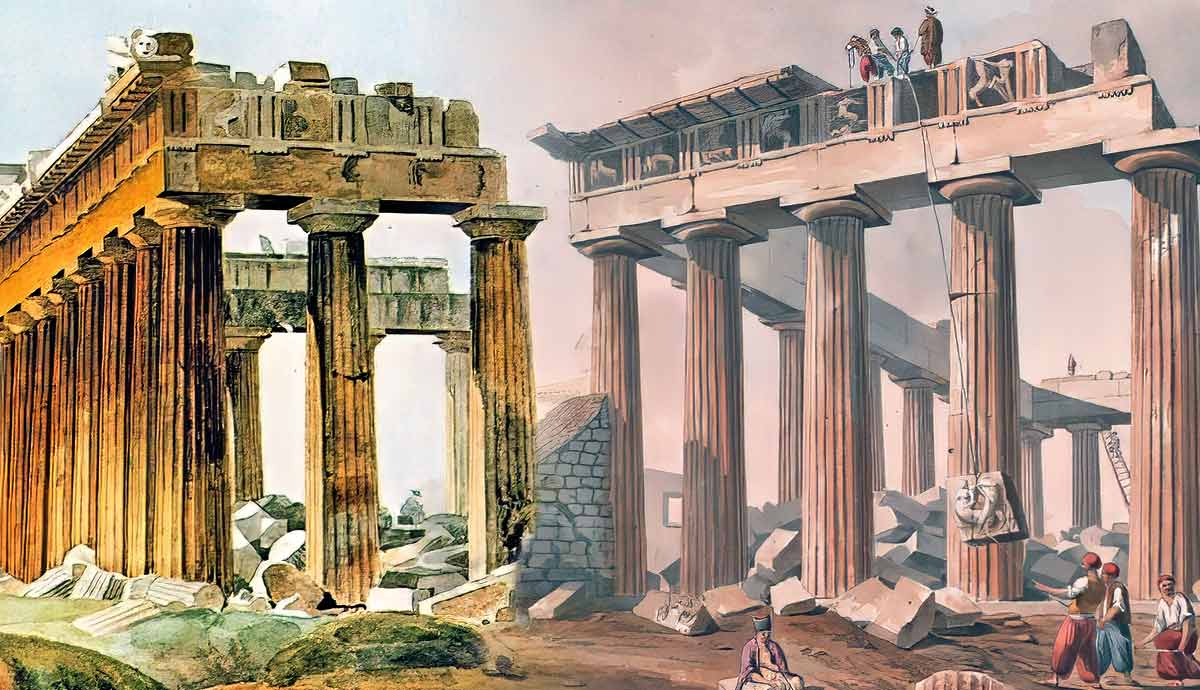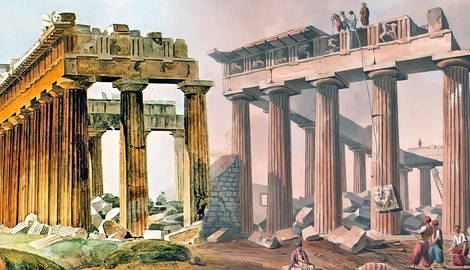
The Parthenon is a must-see for any visitor to Athens. Built over 2000 years ago, the ancient temple is one of those iconic buildings that have come to symbolize Western civilization. Built as a temple for the goddess Athena, the Parthenon has served both as a Christian church and a mosque and has seen multiple transformations throughout its long history.
1. The New Parthenon Is Built on the Ruins of the Old

The 5th century BCE is often hailed as the golden time for Athens. This period was when most of the magnificent public buildings on top of the Acropolis were constructed, and democracy, arts, philosophy, and theatre flourished. After enduring five decades of warfare with the Persians, the Athenians achieved a momentous victory in the Battle of Plataea in 479 BCE. This triumph raised a sense of national pride, and the city thrived economically. The construction of the Parthenon, one of the most iconic structures of ancient Greece, was launched within this context.
The temple’s construction began in 447 BCE and finished in 438 BCE. The location chosen for the Parthenon on top of the Acropolis hill, was not random. There lied the ruins of two earlier temples. An older, unfinished temple, the Pre-Parthenon or Older Parthenon, occupied the same site. The Pre-Parthenon itself had been built on top of an earlier temple known as the Hekatompedon Temple. Both temples were dedicated to Athena, the city’s patron goddess.

The Pre-Parthenon had faced destruction during the Persian sack of Athens in 480 BCE. When the Persians attacked the city, they mercilessly destroyed and burned the still unfinished Pre-Parthenon and other buildings. After the attack, the Athenians did not rebuild the Pre-Parthenon but left the ruins in place for the next 30 years as reminders of the Persian threat. Although little remains visible of the Pre-Parthenon today, fragments of metopes and pediment sculptures from the original temple can be admired at the Acropolis Museum in Athens.
2. The Parthenon Becomes a Christian Church

The Romans took over Greece in 146 BCE, and Athens became a provincial Roman city. Athens kept most of its Classical and Hellenistic characteristics, which were much admired in Rome. Christianity was adopted as the state religion by the Roman Empire in 380 CE, meaning that many pagan temples and sacred sites were repurposed as churches and used Christian worship.
When the Roman Empire was split into two 15 years later, the Eastern Roman Empire (also known as Byzantine Empire) continued to promote Christianity over older pagan religions.

The Parthenon, a temple initially built to honor Athena, was transformed into a church dedicated to the Virgin Mary. The interior of the Parthenon was altered, with additions such as Christian iconography, an apse, and an altar. The Parthenon became one of the most important Christian pilgrimage destinations within the Byzantine Empire. The magnificent temple dedicated to Athena played a significant role in cementing Christian religious practices and rituals in Greece.

Sometime during this period, the massive statue of Athena, sculpted by the renowned artist Phidias, disappeared. Crafted from gold and ivory, the approximately 12-meter-tall statue stood at the heart of the Parthenon in all her beauty and grandeur. What exactly happened to the statue remains a mystery. Likely it was removed in pieces and transported to Constantinople.
It should also be noted that from 1204 and for 250 years, the Parthenon served as a Catholic church, as during that time, Athens was under the control of the Latin Dutchy of Athens, created after the fourth crusade that took down Constantinople.
3. The Parthenon Becomes a Mosque

After the Ottoman Empire captured Athens in 1458, the Parthenon on the Acropolis was transformed once again. The Ottoman Empire, which spanned from the 14th century to the early 20th century, had Islam as its dominant religion. Unlike other empires, however, the Ottoman Empire was tolerant toward other religions. The empire went through more conservative and strict periods, but Christian Orthodox Greeks were allowed to practice their religion and remained mainly Orthodox Christians.
The Parthenon became the symbol of Islamic conquest and dominance over the Greek people. The Parthenon was remodeled to serve Islamic practices. All signs of its Christian past were removed, the images of saints were painted over, and most notably, a minaret was added to the building. The conversion into a mosque represents a significant shift in the religious and cultural identity of the city.
The elaborate friezes, metopes, and pediments of the classical Parthenon suffered extensive damage during this period.
4. The Venetians Bombardment of the Parthenon

The Venetian siege of Athens in 1687 was part of the larger conflict involving the Ottoman Empire and a coalition of European powers, including the Republic of Venice. The primary goal of the Venetians was to weaken the Ottoman presence in the Eastern Mediterranean and to assert their influence in the region. The decision to target Athens was strategic. Athens was important as the Western heart of the Ottoman Empire and held symbolic significance.
During the siege, the Ottomans used the Parthenon and other buildings on the Acropolis as a fortress. As the largest building, the Parthenon was used to store gunpowder and ammunition. In their attempt to weaken the Ottoman defenses, the Venetians targeted the Parthenon with heavy artillery. When the Venetian mortar strike hit the Parthenon, it caused a massive explosion, which blew out the whole central portion of its roof. Several columns, sculptures, and other structures were destroyed.

The Venetians subsequently abandoned Athens in 1688. A small mosque was built inside the ruins of the Parthenon. This phase in the history of the Parthenon is well documented in several paintings and drawings by European travelers. There is even a daguerreotype photograph of this small mosque.
5. Elgin Takes the Marbles

The Parthenon regularly appears in the news due to the long-standing dispute between the Greek government and the British Museum in London. The controversy began with Lord Elgin, who was the British ambassador to the Ottoman Empire from 1799 to 1803. Elgin obtained permission from the Ottoman authorities to make plaster casts and documentation of Greek buildings, including the Parthenon. During this documentation process, a quick decision was made to remove sculptures and architectural fragments from the Parthenon.
Sir Elgin argued that he was acting to preserve the Parthenon marbles and protect them from further damage or destruction. He claimed that the Ottomans neglected the site and that the sculptures were exposed to weathering and vandalism. Assisted by a team of craftsmen, Sir Elgin dismantled numerous sculptures, including the famous Parthenon frieze and metopes, and shipped them to England.

Ultimately, in 1816, Elgin sold the marbles to the British government. The marbles became part of the British Museum’s collection, now known as the Elgin Marbles or the Parthenon Marbles. The controversy surrounding Lord Elgin’s actions arises from questions of ownership, consent, and the ethical implications of removing cultural heritage from its place of origin. Greece has long contested the legitimacy of Elgin’s acquisition and has made ongoing efforts to have the marbles returned to Athens.
6. The Greek State Attempts to “Restore” the Classical Parthenon

The Greek War of Independence, fought from 1821 to 1830, was a conflict which Greek revolutionaries sought to break free from Ottoman rule. The Greeks, inspired by nationalist sentiments and enlightenment ideals, rebelled against Ottoman governance. Support for the Greek cause, a movement known as Philhellenism, grew internationally. Fighters inspired by the Greek cause joined the battle from all over Europe. Notable figures like the poet Lord Byron aided the revolution.

Ultimately an independent Greek state was formed, recognized by the Treaty of Constantinople in 1832. The Parthenon continued to symbolize the Greek national identity, cultural heritage, and resilience.

The modifications done on the Parthenon during this early period of the Greek state’s existence focused on “restoring” the temple to its ancient, classical Greek appearance. Efforts were made to replace damaged or missing architectural elements, such as columns, friezes, and pediments, using available historical records and fragments discovered on the site. These interventions sought to reinstate the Parthenon’s original architectural state. Post-classical additions, including those of the Byzantine, Venetian, and Ottoman times, were removed.
7. Protecting the Parthenon from Tourism and Air Pollution

Greece is one of the busiest tourist destinations in Europe, and few visitors to Athens miss the chance to climb the Acropolis to witness the timeless wonder of the Parthenon. In 2022 the Culture Ministry of Greece estimated that about 16,000 people visit the Acropolis daily during the high season.
Safeguarding the monuments from this number of visitors means restricting touching the monuments with protective bars and limiting access to certain areas. It is a careful balance to allow people to admire and appreciate the Parthenon while also protecting it.
Another modern-day threat to the Parthenon is air pollution, which causes erosion to the marble. Climate change causes extreme weather conditions, and long periods of either drought or heavy rain can damage the structures of the ancient walls and temples. Efforts are also made to monitor and analyze the impact of air pollution on the Parthenon through regular inspections and scientific studies. Protective coatings and cleaning techniques that balance conservation with minimal intervention are being developed to safeguard the marble surfaces. It is also important to raise awareness about preserving this architectural masterpiece for future generations.









